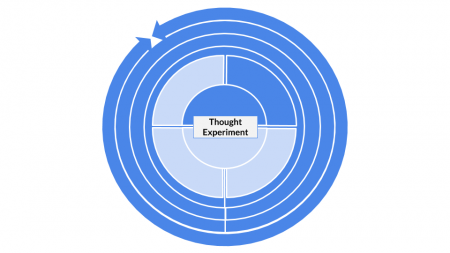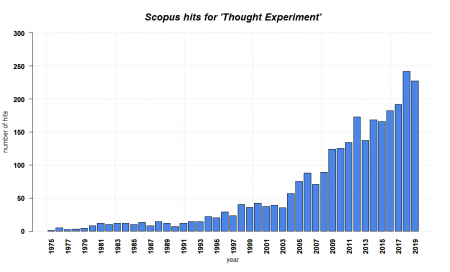Thought Experiments
| Method categorization | ||
|---|---|---|
| Quantitative | Qualitative | |
| Inductive | Deductive | |
| Individual | System | Global |
| Past | Present | Future |
Background
The thought experiment may be as well the oldest method, since the consideration of potential futures is a vital step when our distant ancestors emancipated themselves and became humans. Asking themselves the "What if" questions was a vital step in the dawn of humankind, and both in the west and the east are many of the first thinkers known to have engaged in thought experiments. Methodologically, thought experiments provide a link between the metaphysical -or philosophy- and the natural world -i.e. natural sciences. Equally the ancient greeks as well as the Buddhism and Hinduism are full of early examples of thought experiments. Aristoteles remains a first vital step in the West, and links after a long but slow growth of the importance of the methods into the early enlightenment. Galileo and Newton are early examples of famous though experiments that connect theoretical considerations with a systematic reflection of the natural world. This generation of more generalisable laws was more transgressed with the origin of species by Charles Darwin. This theory was initially one epic thought experiment, and although DNA initially confirmed it, the role of epigenetics was another step that proved rather problematic for Darwinism. Mach introduced the term "thought experiment", and Lichtenberg created a more systematic exploration of thought experiments. Many ethical though experiments gained province in the 20st century, and Derek Parfit is a prominent example how these experiments are used to illustrate and argument cases and examples within ethics.
What the method does
Thought experiment are the philosophical method that asks the "What if" questions in a systematic sense. Thought experiments are typically designed in a way that should question our assumptions about the world, and are thus typically deeply normative, and can be transformative. Thought experiments can unleash transformation knowledge in people as such experiments question the status quo of our understanding of the world. The word experiment is insofar slightly misleading, as the outcome of thought experiments is typically open. In other words, there is no right or wrong answer, but instead are through experiments are form of open discourse. While thus some thought experiments may be designed to imply a presumpted answer, many famous thought experiments are open, and potential answers reflect the underlying norms and moral constructs of people. Hence thought experiments are not only normative in their design, but especially in terms of the possible answers of results.
The easiest way to set up a thought experiment is to ask yourself a "What if" question. Many though experiments resolve around decisions, choices or potential states of the future. A famous example is the Trolley experiment, where a train rolls towards five train track workers, who would all be killed be the oncoming train, unaware of their potential demise. You can now change the direction of the train, and lead it to another track. There, one worker would be killed. Uncountable numbers of variations of this experiment exist, as it can teach much about choice, ethics, and responsibility. For instance would many people change the train direction, but hardly anyone would push a person onto the track to derail the train. This would save the other five, and the outcome would be the same. However the difference between pushing a lever or pushing a person has deep psychological ramifications that resolve around guilt. This exemplifies that the thought experiment does not necessary have a best outcome, as the outcome depends in this example on your moral choices. Some might argue that you should hurl yourself onto the track to stop the train, thereby not changing the countable outcome, but performing a deeply altruistic act that saves everybody else. Most people would probably be unable to do this.
Such deeply normative thought experiments differ from though experiment that resolve around the natural world. Droping a feather and a stone from a high building is such an example, as this experiment is clearly not normative. We are all aware that the air would prevent the feather to fall as fast as the stone. What if we take the air now out of the experiment, and let both fall in a vacuum. Such a thought experiment is prominent in physics and exemplifies the great flexibility of this method. Schrödinger cat was another example of the though experiment, where quantum states and uncertainty are illustrated by a cat that is either dad or not, which depends on the decay of some radioactive element. Since radioactive decay rates are not continuous, but represent a sudden change, the cat could be dead or not. The cat is dead and not dead at the same time. many argue that this is a paradox, and I would follow this assumption with the supporting argument, that we basically look at two realities at the same time. This exemplifies again that our interpretation of this thought experiment can also be normative, since a definitive prove of my interpretation is very difficult. This is insofar relevant, as seemingly all thought experiments are still based on subjective realisations and inferences.
So far, we see that there are though experiments that resolve exclusive about a -subjective- human decision, and other types of though experiment that are designed around setting in the physical world. The difference between these two is in the design of the experiment itself, as the first are always focussed on the normative decisions or people, while the second focus on our normative interpretation of anticipation of a design that is without a human influence. This distinction is already helpful, yet another dimension if about time. Many thought experiments are independent of time, while others try to reinterpret the past to make assumptions about a future about which we have no experience. Though experiments that focus on reinterpretation of the past ("What if the assassination of Franz Ferdinands failed? Would the first world war have happened?") look for alternative pathways of history, often to understand the historical context -and more impotantly- the consequences of this context better. Most though experiments are independent of a longer time scale. These experiments -such as the Trolley experiment- look at a very close future, and are often either very constructed or lack a connection to a specific context. Thought experiments that focus on the future are often build around utopian or at least currently unthinkable examples that question the status quo, either form an ethical, societal, cultural or any other perspective. Such desirable futures are deeply normative yet can build an important bridge to our current reality through backcasting ("What if there is no more poverty, and how can we achieve this?").
All this exemplifies that thought experiments are deeply normative, and show a great flexibility in terms of the methodological design setup in space and time. Some of the most famous thought experiments (tele transportation paradox) are quite unconnected form our realities, yet are in direct connection to our reality. This is the great freedom of thought experiments, as these help us to understand something basically about ourself. Thought experiments can be a deeply transformational methods, and can enable us to learn the most about ourselves, our choices, and our decisions.
The question is now how a thought experiment differs from a real experiment.
Strengths and Challenges
The core strengths of thought experiments is to raise normative assumptions of about the world, and about the future. Thought experiments can thus unleash a transformative potential within individuals, as people question the status quo in their norms and morals. Another strengths of thought experiments is the possibility to consider different futures, as well as alternatives of the past. Thought experiments are thus as versatile and flexible as peoples actions or decision, and the "What if" of thought experiments allows us to re-design our world and make deep inquiries into alternative state of the world. This makes thought experiments potentially time-saving, and also resource efficient. If we do not need to test our assumptions in the real world, our work may become more efficient, and we may even be able to test assumptions that would be unethical in the real world. Schrödingers cat experiment is not only important for physics, but also better for the cat. This latest strengths is equally also the greatest weakness of thought experiments. We might consider all different option about alternative states of the world, yet we have to acknowledge that humankind has a long history of being wrong in terms of our assumptions about the world. In other words, while thought experiments are so fantastic because they can be unburdened by reality, this automatically means that they are also potentially different from reality. Another potential flaw of thought experiments is that thought experiments are only as good as our assumptions and reflections about the world. A four year old making up the thought experiment "What if I have an unlimited amount of ice cream?" would consequently drown or freeze in the unlimited amount of ice cream. Four year olds are not aware of the danger of the "unlimited", and may not be the best thought experimenters. The same holds true for many other people, and just as our norms and values change can the value of specific thought experiments change over time. Though experiments are like a reflections dn any reflection can be blurry, partly, bended, or plain wrong - the last case if we cannot identify our reflection in the mirror of thought experiments.
Normativity
Thought experiments are as we have already learned as normative as are our assumptions about the world. Hume argued that thought experiments are based on the laws of nature, yet here I would disagree. While many famous thought experiments are thus about the physical world, others are only made up in our minds. Many thought experiments are downright impossible to be matched with our reality, and are even explicitly designed to do this, such as Thomas Nagels encyclopaedia of the Universe. It is therefore important to realise that basically all thought experiments are in essence normative, and one could say even downright subjective. Building on Derek Parfit, I would however propose a different interpretation, and propose that we should not measure the normativity of though experiments through the design and setting, but instead by their outcome. Many people might come to the same conclusions within a given though experiment, and some conclusion drawn from thought experiments may matter more than others. Consequently the penultimate question -also for Derek Parfit- is whether there are some thought experiments that are not normative.
Outlook
Much of art and the media can be seen as a thought experiments, and there are ample examples that thought experiments in the media and the arts triggered or supported severe societal transformations. Thought experiments are of equal importance in ethics and physics, and the bridge building of the methodological approach should not be overestimated. Examples from the past prove that thought experiments can enable a great epistemological flexibility and diversity. This flexibility is even so large that through experiments serve as a bridge between the epistemological and the ontological, or in other words between everything we know -and how we know it- and everything we believe. By enabling the transformation of our own most individual thoughts, thought experiments may provide a boat or a bridge to link the metaphysical with the world of knowledge.

